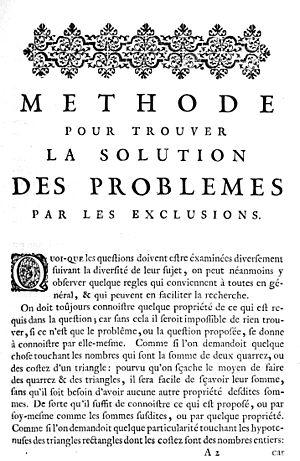Bernard Frénicle de Bessy facts for kids
Bernard Frénicle de Bessy (born around 1604, died 1674) was a French mathematician. He was born in Paris. He wrote many important papers about math, especially about number theory (the study of numbers) and combinatorics (the study of counting and arranging things).
He is most famous for his work on magic squares. A magic square is a grid of numbers where every row, column, and main diagonal adds up to the same total. His book, Des quarrez ou tables magiques, was published in 1693, after he died. In this book, he showed all 880 different types of 4x4 magic squares. A special way to show magic squares, called the Frénicle standard form, is named after him.
Frénicle de Bessy solved many math problems created by Pierre de Fermat. He also discovered a special property of the number 1729. This number is now known as a taxicab number because it's the smallest number that can be written as the sum of two cubes in two different ways. He also wrote a book called Traité des triangles rectangles en nombres, which was published in 1676.
Bessy was part of many science groups, including the French Academy of Sciences. He wrote letters to many famous mathematicians like Marin Mersenne and Blaise Pascal. He was also good friends with Pierre de Fermat, René Descartes, and John Wallis. He was best known for his deep understanding of number theory.
He once challenged Christiaan Huygens to solve a tricky math problem involving equations with whole numbers. A solution to this problem was found much later by Théophile Pépin in 1880.
Frénicle's Method of Exclusions
Frénicle's book, La Méthode des exclusions (The Method of Exclusions), was published in 1693. It appeared in a large collection of scientific papers from the French Academy of Sciences. Even though it was published later, Frénicle probably wrote this work around 1640.
The book starts with a short introduction. Then, it lists ten rules. These rules were meant to be a "method" or general guidelines for solving math problems. During Frénicle's time, "methods" were often used to teach students. However, Frénicle's rules also suggested a new way of exploring math problems, not just teaching them.
Frénicle's book gave many examples of how to use his rules. For instance, he looked at the problem of finding out if a certain integer (a whole number) could be the longest side (hypotenuse) of a right-angled triangle. He used the number 221 as an example.
He applied his second rule, which says: "If you don't know what you're looking for, find its features by building similar numbers step-by-step." He then used the Pythagorean theorem, which relates the sides of a right triangle.
Next, he used his third rule: "To make sure you don't miss any necessary number, set up your search in the simplest way possible." Frénicle then started adding up perfect squares (numbers like 1, 4, 9, 16, etc.). He made tables of his calculations. Rules four to six helped him simplify these calculations. In the end, he found that 221 could indeed be the hypotenuse under certain conditions. He checked his answer by trying it out.
An Experimental Way to Do Math
The example in La Méthode des exclusions shows that Frénicle used an experimental way to do mathematics. This was different from the usual Euclidean approach of his time. The Euclidean method focused on axioms (basic truths) and deductive reasoning (using logic to reach conclusions).
Instead, Frénicle used careful observations to find interesting patterns and ways to build things. He didn't always try to create formal proofs like those in Euclid's books. He even said that his research was "mainly useful for possible questions, using for most of them no proof other than construction." This means he often showed something was true by building it or showing how it worked, rather than by writing a long, logical proof.
Images for kids
See also
 In Spanish: Bernard Frénicle de Bessy para niños
In Spanish: Bernard Frénicle de Bessy para niños



